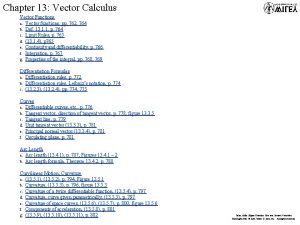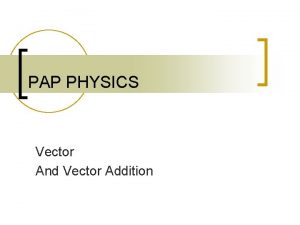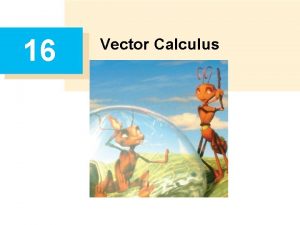The Vector Lecture Or Whats Our Vector Victor
















- Slides: 16

The Vector Lecture Or What’s Our Vector Victor?

Vectors vs. Scalar Quantities • Vector quantities have both a magnitude (measure) and direction. • Vector quantities add graphically • Vector quantities have components usually perpendicular to one another. • Scalar quantities have direction only • Scalar quantities add algebraically (simply add values) • No components • Can have positive and negative values. • THE TEST

Examples • Displacement, velocity and acceleration • Force • Momentum and Impulse • Torque, angular acceleration, angular velocity and angular displacement • Time, mass • Energy and Work • Rotational kinetic energy

Vector Addition • For vectors in same or opposite direction simply add or subtract. • For vectors at right angles use pythagorus to add and get resultant. • For vectors at angles other than right angle break up vector(s) into components, add and then use pythagorus. • Graphically can always use tip to tail and using scaling for magnitude.

Vector Decomposition • Dividing one vector into two component vectors • Components are amount of vector quantity in that direction • Perpendicular components do not affect one another – Parallel Component = R cosine angle – Perpendicular Component = R sine angle • Opposite of vector addition R sine angle Angle R cosine angle R

Use of Velocity Vectors: Wind and Wave Power • Fastest point of sail is nearly perpendicular to wind – Running with wind means you can only go as fast as the wind – Running sideways to the wind means that wind continues to push on you even when you are going the same speed as wind Wind A B C

Vector vs. Scalar Quantities Scalars Vectors • Have magnitude only • Add algebraically • Examples • Magnitude and direction • Add geometrically • Examples – – – Time Mass Energy Temperature Heat and Internal Energy • Represented with normal face type w/o line above value – – – Displacement Velocity Acceleration Force Momentum Torque • Represented using arrows where length is magnitude and direction is direction • Represented in text with boldface or with line above value

Check Question 2 Which of the following represents the resulting vector for the two vectors to the right? A B C

Check Question 1 Which of the pictured vectors are in the same direction? A. A and B B. B and C C. A and C Which of the pictured vectors are equal in magnitude? A. A and B B. B and C C. A and C A B C

Vector Addition • Vector addition is when two vectors are added to become one resultant vector • To add vectors they must be of the same measurement type and unit. • Graphically add vectors by using tip to tail or parallelogram method • Mathematically adding vectors – – Simply add magnitudes if in same direction Subtract magnitudes if in opposite direction Use Pythagorean Theorem if at right angles Direction found using tan q = y/x where y and x are vertical and horizontal measurement of same type

Check Question 3 • Show the perpendicular components of the following resultant vectors. A C B D

Vector Addition Revisited • To add vectors not in same direction or at right angles. – Decompose each vector into perpendicular components – Add components in same direction – Find resultant using Pythagorean theorem – Find angle using tangent or other trig function and components • This is where the law of sines and cosines came from Px Qx Qy Py Q P

Use of Force Vectors: Inclined Plane • Part of the weight tries to push mass into plane while part of weight tries to pull mass down plane • As the angle of the incline plane goes from horizontal to vertical – The amount of the weight into the plane decreases – The amount of the weight down the plane increases – The overall weight stays the same

A Use of Force Vectors: Mechanical Equilibrium • Equilibrium – Forces in horizontal direction add to equal zero – Forces in vertical direction add to equal zero – Motion is that of constant velocity (model 1) • one possibility is the object remains stationary • NO ACCELERATION • Examples – String breaks when ends of string are pulled apart – Unsupported chain cannot be pulled straight – Bridge Demo Variables

Representing Vector Quantities • Text book uses Bold type • Can also use arrow over value • Arrow representation – Length gives magnitude – Direction gives direction

Vector Quantities • Vector quantities are those having magnitude and direction. Non-vector quantities are scalar. – A vector quantity partially goes in one direction and partially in another – The test: does it make sense if you put directions after it? – Examples: velocity, acceleration, displacement, force, momentum and torque • Vector quantities add differently than scalar quantities
 01:640:244 lecture notes - lecture 15: plat, idah, farad
01:640:244 lecture notes - lecture 15: plat, idah, farad Vector victor meaning
Vector victor meaning Thinking language and intelligence
Thinking language and intelligence Our census our future
Our census our future Christ be our light shine in our hearts
Christ be our light shine in our hearts Marcus aurelius our life is what our thoughts make it
Marcus aurelius our life is what our thoughts make it We bow our hearts
We bow our hearts Our census our future
Our census our future Our life is what our thoughts make it
Our life is what our thoughts make it Kitna
Kitna Awareness of ourselves and our environment is:
Awareness of ourselves and our environment is: Is our awareness of ourselves and our environment.
Is our awareness of ourselves and our environment. God our father christ our brother
God our father christ our brother Our future is in our hands quotes
Our future is in our hands quotes Our awareness of ourselves and our environment.
Our awareness of ourselves and our environment. Awareness of ourselves and our environment
Awareness of ourselves and our environment Cosmic address small to large
Cosmic address small to large































